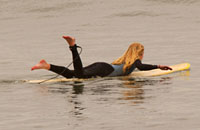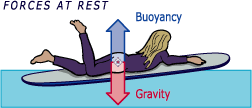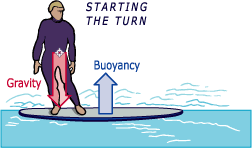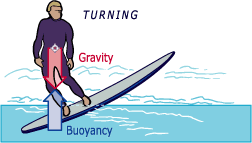|
|

The
Science of Surfing
by Paul Doherty

|
|
Waiting
for a wave.
|
S
itting
on your board, you look behind you and spot an oncoming wave. Your
eyes and brain and body have learned to judge the timing so you
can catch that wave and ride it. You paddle hard, then feel the
acceleration as the onrushing mass of water boosts you to its speed.
Then you stand in balance on the board and savor the forces you
feel as you crank off some turns. When you decide to end your ride,
you step back on your board to drop the tail into the water, putting
on the brakes.
The Joy of Physics
You didn’t need to whip out a calculator to figure out what
was going to happen as you surfed—but there’s a great
deal of physics behind riding a wave. Let’s take a look at
a few places where physics and surfing meet. We’ll start as
the surfer starts, waiting on the board between sets of waves. Then
we’ll examine the acceleration as the surfer catches the wave.
Finally, we’ll look at the forces on the surfboard as it turns.
Waiting
to Go
When you are lying on your board in still water waiting for the
next wave, there are two important forces at work: gravity and buoyancy.
Luckily, these forces are pretty easy to understand.

|
|
As
the surfer paddles out, she is floating almost level with the
surface of the water. Note the gentle wave passing the middle
of the surfboard.
|

|
|
At
rest, the gravitational force and the buoyant force are equal
and opposite. The net force on the surfer plus the board is
zero.
|
Gravity
This force pulls on every atom in you and in your board—yet
it behaves as if it were acting just at your center of mass. For
most people, their center of mass is conveniently located behind
their navel in the middle of their body when they’re standing
up straight. Your center of mass is your balance point. Place a
support under your center of mass and you can rest in balance. (We’re
ignoring the surfboard for the moment. The board isn’t massless,
of course, but physicists tell these little lies all the time to
help them get to the heart of a problem.)
Buoyancy
This is an upward force created by the still water pushing up on
the board and is known as a hydrostatic force (a force exerted by
a liquid at rest). The water exerts its force on every part of the
board that it touches, yet the buoyant force acts as if it were
pushing up on the board just at the center of buoyancy, which is
the center of mass of the water displaced by the board. (When Archimedes,
a mathematician of ancient Greece, discovered the mathematics of
buoyancy while bathing, he became so excited that he jumped out
of the bath and ran naked through the streets shouting "Eureka!—I’ve
found it!"—or so the legend goes.)
Net Force
Since you’re staying in one place, you are not accelerating.
And, thanks to Sir Isaac Newton, we know that the sum of all the
forces acting on you—the net force—is zero. No acceleration
means no net force. It’s great to know the answer before you
start to look at the physics. (Note, however, that you can be moving
at a constant velocity even when the acceleration is zero; acceleration
produces changes in velocity.)

|
|
Move
back on a surfboard, behind its center of mass, and the nose
of the board tilts up until the buoyant force aligns with
gravity once again. As this surfer moves to the right, the
tail of the board pushes hard on the water it’s moving
through, bringing him to a stop.
|
Balance
The most important thing for a beginning surfer to learn about is
balance. If the downward force of gravity and the upward force of
buoyancy are in line, they add to zero and things are stable. Slide
backward on your board, though, and the downward force of gravity
moves behind the upward buoyant force. When these two opposing forces
get out of line, the board will experience a torque, or twisting
force. When you move backward, the torque twists the board so that
the nose begins to go up and the tail begins to go down. This changes
the position of the water displaced by the board and also changes
the position of the buoyant force. The board rotates until gravity
and buoyancy come into line again. By shifting your weight relative
to the center of mass of the board, you can tip your board nose
down, nose up, right-side down or left-side down.
The Physics of Turning
|
First
the surfer moves back.
|
Then
the board responds by rotating.
|

|

|
|
When
the surfer moves back on the board, gravity and buoyancy move
out of alignment and create a torque—a twisting force—on
the surfboard. The board rotates until the forces are realigned.
|
The
surfboard rotates until the buoyancy force through the center
of mass of the displaced water is aligned with the gravity force
on the surfer. As the board rotates, the center of buoyancy—the
center of mass of the displaced water—moves toward the
back of the board. When buoyancy and gravity are again in alignment,
there’s no longer any torque.
|
|

|







